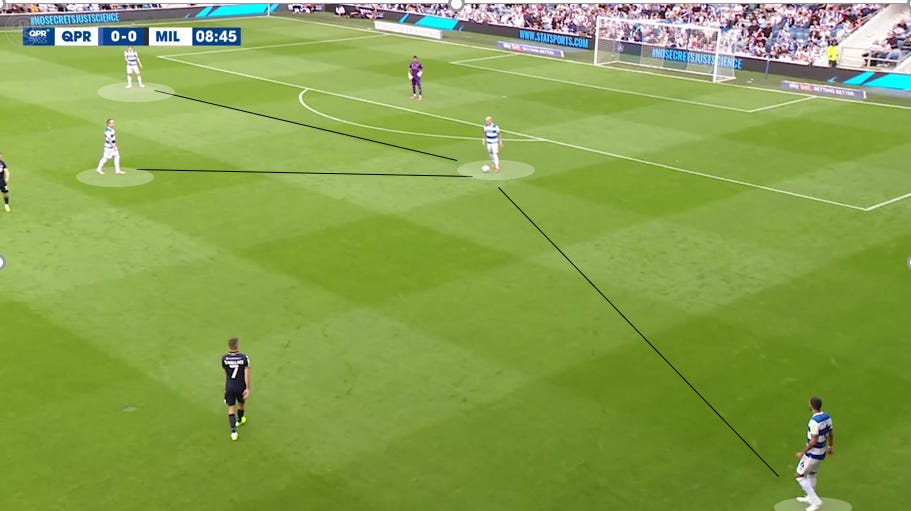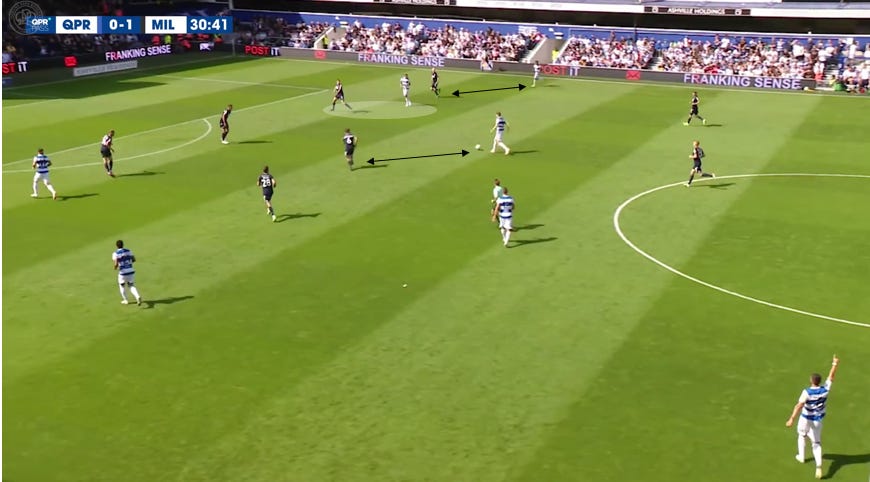How Millwall stifled QPR’s attack
A quick look at how Millwall went about stopping QPR, and what went wrong for Mark Warburton's side.
QPR began the season with a 1-1 draw at home to Millwall at the Kiyan Prince Foundation Stadium on Saturday against a very well drilled Millwall side. There’s been lots of talk about QPR’s lack of actual attacking threat, so I’ve tried to break down the game to see what went wrong, and why we struggled to create any big chances.
There has been lots said about Millwall sitting in a deep block, which is true in their defensive phase, but they were also sometimes proactive in trying to stop QPR building a clean first phase. Using a 5-3-2/ 5-4-1 shape, Afobe as in this case opted against pressing the ball-playing centre back, whilst George Saville tended to man-mark Johansen, or at least be within close contact in an attempt for Rangers to send it long.
Rangers used a common build up shape (3-1) with the wider CB’s in the half space channels and pivot dropping to overload but with a lack of options ahead of Johansen never really materialised the fluid interchanges we are used to seeing.
Another route of build-up was through Rob Dickie. He attempted 6 dribbles, completing 4 of them (the most in the game). Shown below is how he built from the back by opening his body with his first touch to resist the Millwall press and go onto create his solo goal.
It took us after the opening 20 minutes for Rangers to get onto the ball with greater ease and utilise Johansen’s control in the middle of the park and like Rowett said post match, “he helps to make QPR tick”. Lacking control of the game was down to losing second balls, especially in key areas of the pitch.
Here, in the opening 10 minutes, is Millwall’s goal and the eye opener for Rangers. The ball is enters the 6 yard box and both De Wijs and Barbet are going for the ball whilst Wallace is ball watching. Wallace and McNamara create an overload on the edge of the box- both free to roam. The ball falls neatly to Wallace, who is closed down somewhat by Lee Wallace eventually, before Jed Wallace hits a lovely strike past Dieng. Note that perhaps Dieng is slow to react being unable to sight the ball from De Wijs and Afobe.
Surprisingly we seemed to ignore the threat of Jed Wallace from second balls frequently in the game, especially from set pieces where QPR would allow him to be unmarked on the edge of the box
Stefan Johansen and Rob Dickie show more proactivity to get out to Jed Wallace than when he scored his goal, but he manages to drive a volley low and hard on target but had it not been for the ever present De Wijs throughout the game, Dieng might have been tested a lot more.
Once managing to control the game with possession and having built up from the first phase of play, beating the compact low 5-3-2 block was going to be a tough nut to crack. Rangers certainly possessed intelligence in some aspects of our attacking play but we also showed a real hindrance to capitalise on our intelligence.
As shown Millwall set up in the 5-4-1 (RB out of shot) with Johansen sitting in front of them with possession. Lee Wallace is high and wide, whilst stretching the back five as McNamara is drawn with him, creating a gap between Ballard and McNamara. This is also helped by Austin pulling Ballard across, creating that gap but no one is penetrating the space.
This is down to two things. Willock dropping deep to give an option when could be running into the space, and also the fact we possess two very similar striking profiles that play with their back to goal and showed very limited movement on Saturday.
This is another example of the issues of having Dykes and Austin alongside one another. Willock comes to give an option in an area of space. Ballard decides to push high and aggressively towards Willock to prevent him turning whilst leaving a huge amount of space in the backline (red area). It didn’t cause Millwall a problem because of our lack of movement but if Austin moved as shown, and Willock used a lay off, for the striker to be played through, Rangers would have created a simple yet effective “Up-back-through” to open Millwall apart and create a big chance.
Austin and Dykes again in similar positions, making Millwall’s life a lot easier as we lacked any real penetration off the ball with Willock playing the “Chair role” in his absence.
This move above starts in transition, with Austin the spearhead of the attack, his back to goal. As shown, there is huge gaps behind the back line in the “half half” areas I mentioned prior to the game but again, a lack of penetration or pace to capitalise on those spaces. Austin’s linkup is also poor, but the options are all behind him and the Millwall wing backs. We’re starting to show why we are after the profile of a striker such as Andre Gray whose pace can be used to such effect in behind (see below our average positions from Saturday).
This is just prior to Dickie’s strike and there are both good and bad parts to this move (excluding the wonder strike). We use intelligence with Odubajo playing high and wide to pull Scott Malone out, same too with Dykes in the space between the full back and CB to open up space for Dickie to shot. Surprisingly, Kieftenbald does not close down Dickie whatsoever, leaving him with a free shot on goal, and what a goal it was!
But, we only registered a total xG of 0.44 (2nd lowest in the league this weekend) indicating the lack of scoring positions Rangers got into. Ideally , you want Dykes and Austin showing movement in the central areas giving options, but instead we are relying on Dickie as our offensive output. Austin and Dykes combined had one shot on Saturday of our 11, so they really didn’t get all too involved or get the service either.
Here is the Austin chance and it was from 23 yards too. Moses again creates the space for Austin to shoot by occupying Malone however we are numerically 4v3 anyway. Dykes is free back post but Austin shows a strikers’ selfish nature and hits one comfortably enough for Bialkowski to parry. Another moment where intelligence could have created a more imposing chance.
An attack down our preferred left hand side this time, and its a 2v2 compared to our usual numerical overload. Millwall are comfortable in defending this as Willock opts to cut inside, but this move epitomises the real miss of Chair on Saturday.
With Millwall comfortable numerically in the box, Rangers usually like to create openings in the half spaces as highlighted. Only Ball is there, but as a backwards option so we cannot create a fluid opening, instead Willock crossing an aimless ball into the box for Ballard to clear comfortably.
Early in the second half, Rangers show some offensive improvement and created arguably our best chance of the game through Chris Willock.
He takes Kieftenbald on 1v1 with success and is able to drive into the space infront of both Ballard and himself.
In the second phase of the chance, Ballard here is less aggressive than he was on Willock in the first half, showing him inside towards Shaun Hutchinson. Willock manages to curl a shot just inside of the far post, but Bialkowski manages to push it past the post to prevent Millwall from conceding a 2nd.
But quickly after that the game turned on its head and Millwall became most dominant in the final stages of the game. Another chance from the edge of the box, where Millwall like to leave a man free there from loose balls goes beckoning.
Again, Rangers were too slow to react (gap shown) and another lifeline in the game. This is something Warburton needs to ingrain in the players, as we conceded far too many shots last season (190-the 4th league highest).
So, Overall:
We lost too many second balls early on- struggled to get into the game
Our Strikers movement was static- similar positions throughout + didn’t capitalise on space
We really missed Chair in our attacks- no one in the half spaces + Willock was unable to penetrate.
Millwall defended well in their compact 5-4-1/5-3-2 shape. Were aggressive and brilliant aerially
Jed Wallace caused QPR huge problems, specifically marking him
Dickie was pivotal in creating build-ups
Fair play to Millwall, they read us well in most situations and capitalised on our weaknesses with defending second balls.

















